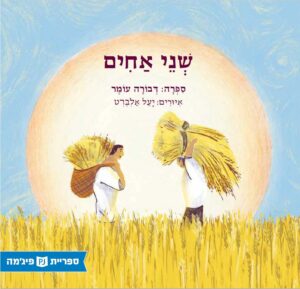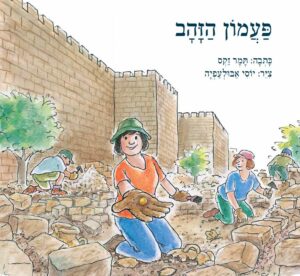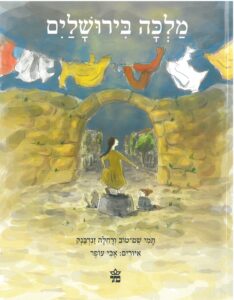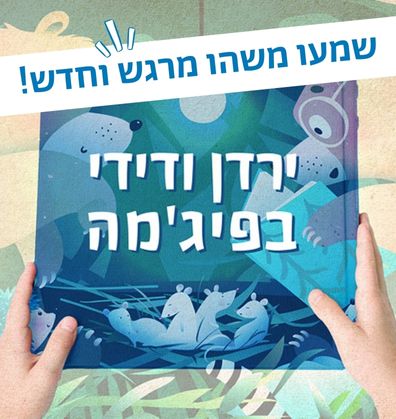מְקוֹרוֹת וְתַרְבּוּת
ירושלים
הכנו עבורכם רשימת הספרים מומלצים בנושא ירושלים- עיר הבירה של ישראל ששמותיה וכינוייה רבים! אנו מזמינים אתכם/ן להכיר דרכם את רובדי ההיסטוריה בארץ ישראל ולטייל בנבכיה.
תוכלו למצוא מתחת להמלצות הספרים מגוון רעיונות לפעילויות בעקבות הקריאה עם הילדות והילדים.
סְּפָרִים
Book-Related Family Activities
Proposed Family Activities:
- You may want to leaf through the book and look for all the activities that the brothers do together. Perhaps your child can think with you about all the things around the house that are easier and more fun to do together by joining forces.
- There are many words in Hebrew that describe farming. Does your child know the names of all the different actions? You could look at the illustrations depicting farming activities in the book, and try to do the same using hand gestures.
- Each of the brothers is considerate of the other, and gives up his share without ever having been asked to do so. You may enjoy making an illustrated list together of examples of actions that show how each of you has conceded and helped members of your family.
- Like the brothers in this book, you too can make a heartwarming surprise for your child during the night, to which they will open their eyes in the morning. Afterwards, your child may surprise you too!
- The brothers in this story understand that dividing things up equally is not always the fairest method, and therefore each of them wishes to give up some of his share for his brother. You may want to discuss the different needs of your own family members, and promise your child that even when they do not get exactly the same things as their siblings, they too will always get what they need.
- “Each of us has a city called Jerusalem” (Natan Yonatan): the book informs us that the Temple in Jerusalem was built on the exact spot where the two brothers met. Having read this story, you may want to look for pictures of Jerusalem together, sing songs about the city, and tell your children about “your Jerusalem”.
Proposed Family Activities:
- You may enjoy reading this book together and asking for your child’s opinion – do they think this story really happened? How did the friendship between the shoemaker and the Emir “save” Jerusalem? Perhaps you could choose one elderly friend or member of your family, and suggest that your child interview them about their childhood. The interview can be recorded, drawn or written down, to be kept for posterity.
- This story takes place in Jerusalem at the beginning of the 20th Which characteristics of Jerusalem can you identify in the illustrations? You may want to look for other pictures of Jerusalem from the same period, and compare it to contemporary ones: does Jerusalem still look this way? What about it has remained the same, and what has changed?
- The narrator’s grandfather was a craftsman, a shoemaker. Perhaps you would enjoy discovering the occupations in which your family members engaged in past generations. Is any of the professions passed down from one generation to the next? You may want to create a family tree, and draw a symbol of each family member’s profession alongside their name.
- Many last names provide information about one’s family history. Does your last name hold a clue about an ancestor’s occupation? Or the place from which your family immigrated to Israel? Or any other past family characteristic?
- By squeaking, the boots remind the Emir of the help he received from his friend, the shoemaker. Perhaps you can remember someone who once helped your family. What reminds you of them? Together, you may want to think of ways to make them happy.
- Many past professions are disappearing – milkmen, watchmakers, blacksmiths, streetlamp lighters, etc. Can you think of any other occupations that no longer exist? Perhaps you could imagine together what the world would be like if other professions we now have will no longer be required. Which occupations might come in their stead?
להמחיז יחד את הסיפור
אתם יכולים להמחיז יחד את הסיפור. כדאי לנסות לדמיין את ההמולה, את המראות ואת ההתרחשויות בסביבה.
להתבונן לבד באיורים של יוסי אבולעפיה
כדאי לאפשר לילדים להתבונן לבד באיורים של יוסי אבולעפיה. האם משהו הצחיק אותם באיורים? האם ילדי הגן מזהים את כל הדברים שמצאו האנשים באיורים? אפשר לחפש באיורים חפצים בלתי מוכרים (למשל: מנורת שמן, קסת ודיו, נבל), ולשאול את הילדים למה הדברים דומים ולפרש אותם לילדים.
גילויים ארכיאולוגיים
אנחנו לא באמת יודעים איך חיו האנשים לפני אלפי שנים, אך גילויים ארכיאולוגיים מסייעים לנו לדמיין את אורח חייהם. נסו להשוות את האווירה של ירושלים בתקופת בית-המקדש עם המציאות היום (כלי תחבורה, לבוש, אוכל וכדומה).
בהשארת הסיפור
בהשארת הסיפור ולקראת יום ירושלים וחג שבועות, ניתן לקשט את הגן ברוח תקופת בית-המקדש.
להזכיר לילדים חפצים שאבדו לילדים
אפשר להזכיר לילדים חפצים שאבדו לילדים, ואם מתאים – לספר להם על חפץ אהוב שפעם אבד לך. האם האבדה נמצאה? איך הרגשתם כשגיליתם שהחפץ חסר, או כשמצאתם אותו? כדאי לאפשר לילדים להעלות רעיונות שיסייעו להם לשמור על חפצים שחשובים להם, ולשתף אותם בדרכים שבהן אנו שומרים על חפצינו.
"משחק הסימנים"
המשנה מנחה את מי שאיבד דבר-מה לתאר אותו על פי סימנים מזהים ייחודיים לו כדי לקבלו חזרה. אפשר לשחק יחד את “משחק הסימנים”: בזמן שאחד הילדים עוזב את החדר, חבריו בוחרים חפץ שנמצא בגן. עם חזרתו לחדר, הילד מנסה לנחש מהו החפץ המוסתר, תוך תיאור החפץ על פי סימנים מזהים.
לשוחח עם הילדים על שמירת חפצים
כדאי לשוחח עם הילדים על שמירת חפצים, וגם ללמד אותם כי גם היום יש מקומות שאליהם מביאים אנשים דברים שמצאו (למשל, למשטרה או למחלקות אבדות ומציאות במקומות ציבוריים). אפשר להציע לילדים והורים לטייל בעיר ולחפש מודעות על חפצים או בעלי חיים שאבדו או נמצאו. האם מצוינים במודעות סימנים מזהים, פרטי קשר, תמונה? תוכלי לבקש מהם לצלם או לתאר את המודעות. בגן הילדים יכולים להכין שלטים לדוגמה, עם תיאורים של חפצים שאבדו או נמצאו.
להרחיב את הסיפור
תוכלו להרחיב את הסיפור ולספר לילדים על אבן הטוען, מעין “אגף מציאות” מתקופת הבית השני. ומה קורה אצלך בגן? האם יש לכם ארגז מציאות או דרך אחרת להשיב חפצים אבודים? אפשר להעתיק את מנהג אבן הטוען לגן, ולקבוע מקום מרכזי בו יוכלו ילדים להכריז על מציאות ולחפש חפצים אבודים.
להציע למשפחות לבקר במוזיאון או באתר ארכיאולוגי
בעקבות הסיפור על פעמון הזהב כדאי להציע למשפחות לבקר במוזיאון או באתר ארכיאולוגי. ואם מתאים, אפשר גם לבקר בירושלים ולהשוות אותה עם תיאורי העיר בסיפור.
להמחיז יחד עם הילדים את הסיפור
בעזרת תחפושות פשוטות אתם יכולים להמחיז יחד עם הילדים את הסיפור. כדאי לנסות לדמיין את ההמולה, את המראות ואת ההתרחשויות בסביבה.
להתבונן באיורים של יוסי אבולעפיה
תוכלו להתבונן באיורים של יוסי אבולעפיה וליהנות מהם יחד. האם משהו הצחיק אתכם באיורים? האם ילדיכם מזהים את כל הדברים שמצאו האנשים באיורים? אפשר לחפש באיורים חפצים בלתי מוכרים (למשל: מנורת שמן, קסת ודיו, נבל), לשאול את הילדים למה הדברים דומים ולפרש אותם לילדיכם.
תקופת בית-המקדש
אנחנו לא באמת יודעים איך חיו האנשים בתקופת בית-המקדש, אך גילויים ארכיאולוגיים מסייעים לנו לדמיין את אורח חייהם. נסו להשוות את האווירה של ירושלים בתקופת בית-המקדש עם המציאות היום (כלי תחבורה, לבוש, אוכל וכדומה).
להיזכר יחד בחפץ אהוב שאבד לילדיכם
נסו להיזכר יחד בחפץ אהוב שאבד לילדיכם ואולי גם לכם. האם האבדה נמצאה? האם אתם זוכרים מה הרגשתם כשגיליתם שהחפץ חסר, או כשמצאתם אותו? כדאי לאפשר לילדים להעלות רעיונות שיסייעו להם לשמור על חפצים שחשובים להם, ולשתף אותם בדרכים שבהן אנו שומרים על חפצינו.
לשחק יחד את "משחק הסימנים"
המשנה מנחה את מי שאיבד דבר-מה לתאר אותו על פי סימנים מזהים ייחודיים לו כדי לקבלו חזרה. אפשר לשחק יחד את “משחק הסימנים”: משתתף אחד עוצם עיניים, והמשתתף האחר בוחר חפץ קטן ומסתיר אותו. הוא מתאר את החפץ על פי סימנים מזהים, ועל המשתתף שעוצם את עיניו לנחש מהו החפץ שהוסתר.
להרחיב את הסיפור
תוכלו להרחיב את הסיפור ולספר לילדים על אבן הטוען, מעין “אגף מציאות” מתקופת הבית השני. אפשר לשוחח עם ילדיכם על שמירת חפצים, וגם ללמד אותם כי גם היום יש מקומות שאליהם מביאים אנשים דברים שמצאו (למשל, למשטרה או למחלקות אבדות ומציאות במקומות ציבוריים).
לבקר במוזיאון או באתר ארכיאולוגי
בעקבות הסיפור על פעמון הזהב כדאי לבקר במוזיאון או באתר ארכיאולוגי. גם אתם יכולים להמציא סיפורים מאחורי הגילויים השונים! אפשר גם לבקר בירושלים ולהשוות אותה עם תיאורי העיר בסיפור.
Family Activities
- Many children like to dress up, and not just on Purim! You may enjoy making costumes using clothes, scarves, and other accessories found at home, and have a family costume party.
- Do you remember any special childhood costumes? Perhaps you also got dressed up as a king or queen? You may want to share those memories with your child. You could look through old photo albums, and be reminded of costumes worn by parents, siblings and children.
- There are many children nowadays who also need Purim costumes. Do you have any costumes you no longer need at home? You could donate them or have a give ‘n’ take second-hand costume fair in your school or neighborhood.
- Malka discovers artists practicing various kinds of art at the Bezalel building: weaving, jewelry-making, and painting. What kind of arts does your child enjoy engaging in? In the story, each painter paints Malka a little differently. You may want to make portraits of your own family members. Do you also find it difficult not to move? Do you recognize yourselves in the portraits you painted?
- You should encourage your child to dream, and dream big! You may want to ask your child what their dreams are, and share with them a dream that you have made come true, or perhaps in one you still hope to make true someday. Perhaps, like Malka and Boris, your dreams will also come true!
- The streets of Israel have undergone many changes since Bezalel Art School was first opened. You may want to look at the illustrations together, and compare them to this day and age: are we still allowed to wander around outside on our own? Do you live in an area where there are still walkways without cars or traffic lights? It would be advisable to speak to your child and emphasize the fact that this story is an imaginary one. You could explain that books, as well as movies, are often unlike reality, and that in truth children must never take a walk with a stranger.
- After you have read the story, you may want to visit a nearby art museum or gallery with your child. You could also go online and look at images from art exhibitions across the globe.
- Bezalel Art School is well-known in Israel today, but few know the name Boris Schatz. Many people have done great things but are not remembered for them. Try to think of a person in history that you have heard of or know about, whose story you would like to share with your child. You could create a short book about this person and send it to us.

 Two Brothers and the Temple Site
Two Brothers and the Temple Site  The Boots that saved Jerusalem
The Boots that saved Jerusalem  The Golden Bell
The Golden Bell  Malka, a Queen in Jerusalem
Malka, a Queen in Jerusalem 
